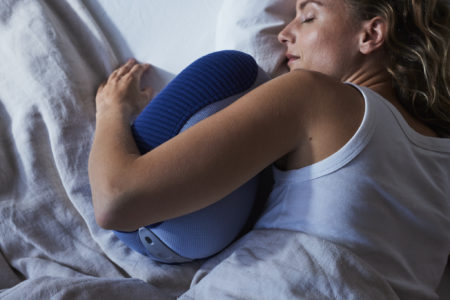
by Baginda Tirtadji | Tuesday, August 30, 2022 | Features, Product, Sleep
Today we introduce to you the newest function for Somnox 2: Airplane Mode
What Is Airplane Mode?
Almost all smartphones and electronic devices nowadays have a setting called ‘airplane mode’. This name has come about as the function was primarily launched in the aviation industry. The function makes sure that all Bluetooth, WiFi and other data traffic on your electronic device switches off. However, you can still use your Somnox when airplane mode is enabled.
What Happens When I Enable Airplane Mode?
By enabling airplane mode, both Bluetooth and WiFi on your Somnox switch off. This means that you can no longer connect your Somnox to the mobile app. However, you can still enjoy your breathing program or exercise and Somnox sounds as on your Somnox saves these settings by itself.
When your Somnox is turned on, it is continually searching for a connection in the background. This uses battery power. By enabling airplane mode, your Somnox uses less battery power so that you can enjoy your Somnox longer.
And we all know: more Somnox = more rest!
Curious to know how you can enable airplane mode on your Somnox?
Read all about it!
Tip: Try airplane mode on route to your next destination!

by Luciënne Lieshout | Thursday, August 18, 2022 | Breathing, Research, Sleep
Does someone need a hug? Whether you consider yourself to be a natural “hugger” or not, giving and receiving hugs can benefit both your physical and mental health.
Hugging stimulates the production of the hormone oxytocin in the body. This feel-good hormone leads to feelings of less stress and improved wellbeing.[*]
It gets even better because you don’t need to wait around for someone to hug you. You can reap the benefits of hugging all on your own. Let’s find out how.
History of Hugging
Hugging and embracing one another has always been an important part of the human experience. Most babies experience their first hug at birth when they are placed into their parent’s arms. For children, hugging and embracing are important elements in their emotional upbringing. Hugging can lead to feelings of attachment and greater self-confidence.[*]
Throughout history, hugging has been viewed as a warm greeting. It is often used as a show of affection, appreciation, or gratitude. Hugs are also typically given as a way to offer congratulations or condolences among friends. A hug tends to be viewed as a warmer greeting than a handshake. [*]
People who hug when greeting others are generally viewed as open and friendly. Research shows that people who grew up with frequent hugs are more likely to hug others as opposed to other forms of greeting, such as a handshake.[*] Most of us have had the experience of meeting someone new who immediately embraces us and declares that they are “a hugger.”
Mental Health Benefits of Hugging
Hugging is a powerful way to improve your health thanks to the hormone oxytocin. Oxytocin is a hormone that is released with therapeutic touch like hugging.[*] It is also released during childbirth, breastfeeding, and sexual activity. It’s produced in the hypothalamus (which is part of your brain and controls the autonomic nervous system) and has been linked to improved quality of life and enhanced feelings of wellbeing.[*] Oxytocin has anti-stress effects too. Here are just a few of the benefits you can expect from a hug.
Less Stress
There’s a reason why you usually feel calmer after hugging a loved one. A 2014 study of 404 healthy adults found that being hugged has a stress-buffering effect. The data suggested that hugging may effectively convey social support.[*] Even newborn babies display less stress after receiving a hug or light touch.[*]
Feel Better
Receiving a hug has a powerful effect on your quality of life. People who regularly hug those in their lives tend to experience better relationship functioning. They also report higher levels of overall wellbeing.[*]
Stronger Immune System
The benefits of hugging go far beyond mental health. A 2014 study found that when study participants received regular hugs, they were less likely to become sick. After being exposed to the common cold virus, the individuals who had been in the hugging group experienced less severe illness than those in the control group.[*]
Lower Blood Pressure
A 2003 study found that physical contact such as hugging or holding hands led to lower blood pressure and reduced heart rate. Even when study participants were asked to do something stressful such as giving a public speaking presentation, a hug still reduced their blood pressure and heart rates.[*]
Can You Hug Yourself?
The health benefits of hugging are exciting but what do you do if there’s no one around to hug? Fortunately, you can still score positive health outcomes by hugging yourself.
A 2011 study found that crossing your arms across your midline can lower painful sensations in the body. Study participants received painful stimuli and noticed that the pain felt less intense when they crossed their arms in a self-hugging position. Researchers hypothesized that this hugging position may interfere with pain signals to the brain.[*] By interrupting pain signals before they reach the brain, hugging yourself reduces pain.
To start reaping the benefits, try wrapping your arms around yourself and taking a few deep breaths. For added comfort (and deeper, more even breathing), hug the Somnox 2 Sleep Companion as you fall asleep.
You probably know how it feels to spoon someone or be spooned by someone. Somnox has been designed to be a comfortable, useful, and easy to cuddle sleep companion. Comfort is mainly ensured by the ergonomic shape of Somnox and the material used to cover it. You can hug Somnox at night like your pet – and snooze off to a better night’s rest.
Keep Hugging
The health benefits of hugging are wide-ranging and include decreased levels of stress, lower blood pressure, and a stronger immune system. You can start adding these health benefits to your life right away. Make a note to hug your loved ones more often. And don’t forget about hugging yourself or the Somnox 2 Sleep Companion to start feeling better now.
Want to find out if Somnox could be something for you? Then you should definitely take our sleep test!


by Luciënne Lieshout | Monday, August 15, 2022 | Breathing, Research, Sleep
Sleeping at work—have you done it? Thought about doing it? Know people who do it? The idea of sleeping at work seems like a comical trope, but it’s surprisingly common. Some believe sleeping at work is unprofessional and that employers should discipline employees for doing it. Others believe that napping during the day can improve productivity.
Who is right? In this post, we will explore the issue of sleeping at work. We will discuss the benefits of napping at work and things employers should consider.
Employees in these industries admit to falling asleep at work
So, who is falling asleep at work? Amerisleep, a mattress company, surveyed 1,001 workers across various industries to answer this question. They examined 12 sectors. A whopping 70% of tech workers admitted to sometimes sleeping on the job—this was the highest group.
The industry least likely to sleep at work was the arts, entertainment, and recreation. Still, 35% of workers in this industry admitted to sometimes sleeping on the job.
What does this tell us? No matter which industry you work in, it’s likely that you’ve caught yourself (or a coworker) dozing off at work. If you have, you’re not alone.
Naps during work hours improve performance
Scientific research has established that sleep deprivation causes a dip in productivity at work. It also has negative effects on health.
A study in the Journal of Sleep Research found that naps can be a part of a comprehensive alertness-management strategy. In operational settings, naps can help manage fatigue and allow workers to stay alert throughout long shifts. This promotes safety for workers who work around dangerous equipment.
But what is the optimal nap length and how long do the effects of naps last?
How long should employees nap?
One study showed that short naps (10-30 minutes) help workers feel more awake and improve performance. Long naps were associated with less productivity and sleep inertia. Sleep inertia is that groggy, disoriented feeling you get after waking up from a long nap or after getting less than six hours of sleep.
How long do the benefits of napping last?
Another study showed that the beneficial effects of short naps (5-15 minutes) have beneficial short-term effects that last around 1-3 hours. Naps longer than 30 minutes can induce sleep inertia for a while, but once feelings of drowsiness and confusion wear off, the cognitive benefits of the long nap last much longer, up to many hours.
Sleeping at work helps you regulate your emotions
Do you dread looming deadlines? What about frustration over a difference of opinions with a coworker or boss? How about just plain stressed out? If you’ve ever held a job on the planet Earth, the likelihood is high that your answer is “yes”.
Even when we enjoy our responsibilities and the people we work with, occasional negative emotions are inescapable in the workplace as they are elsewhere in life. And for some, the workplace can be rife with negative emotions.
So, what can be done to help us deal with these challenging emotions? You guessed it—napping.
Researchers at the University of Central Florida College of Medicine found that daily 20-minute naps were positively correlated with reduced stress in med students. The ability to manage stress can be paramount to your mental health and success at work.
Other researchers found that napping actually helps you evaluate other people’s emotional states by promoting better recognition of emotional facial expressions. The boost you get from napping to evaluate facial cues can certainly be helpful for navigating a team environment.
Should workplaces provide places to nap?
The blurring of the work-life boundary
The technology of the past decade allows work to contact us anytime, anywhere. As a result, the boundary between work and personal life has eroded for some. Extra work time pushes back non-work priorities that the person must take care of later and later. This pushes back bedtime and results in a loss of sleep. In other cases, some remain awake answering emails on their phones or performing other tasks when they would normally be sleeping.
The blurring of the work-life boundary and the resulting loss of sleep is not just about time management. The added stress that follows employees home after working hours takes a toll, causing sleep problems. Up to a third of all adults experience chronic insomnia. More occasional insomnia symptoms affect up to 50% of adults. No wonder so many employees have trouble staying awake!
Nap rooms in the workplace
We know that a large percentage of American workers experience sleep deprivation and sleep disorders. We also know that feeling tired leads to a loss of productivity and safety hazards. So should companies provide spaces for employees to take power naps at work?
The answer is “yes!” according to some of the largest, most innovative companies in America including Google, Uber, and Zappos. Sleep science has shown that napping leads to better health and increased productivity. So it is in a company’s best interest to provide nap rooms or sleep pods where employees could take short naps during work hours.
Of course, there are logistical questions to consider. How should a company allow a worker to nap? Should employers pay employees to nap? Does the employee have to stay later to make up the nap time?
As more and more companies put nap rooms and napping policies in place, the answers to those questions will be revealed.
Power nap with Somnox to regain your focus at work
Somnox is a Breathe & Sleep Companion that helps you relax and sleep by helping you regulate your breathing. Thousands have benefited from Somnox helping them fall and stay asleep at night.
But nighttime sleep isn’t the only thing Somnox can help with. Somnox can be used any time of day to help you unwind, calm down, meditate, or nap. The sleep companion is a 24-hour resource for self-care.
If you work from home, Somnox is easy to reach for when you’ve been chugging along since morning and feel yourself start to fade in the afternoon. Then all you need to do is cuddle up with your Somnox, draw the shades, and set an alarm for anywhere from 5 to 30 minutes. After snoozing for a short while, you should wake up refreshed and ready to refocus yourself on your work for the rest of the afternoon.
If your employer permits napping and either provides nap rooms or if you have an office door that shuts, bring your Somnox to work if you know you have a long day ahead of you and know you’ll need a nap.
It never hurts to take a moment for yourself so you awake renewed and ready for everything the rest of the day will throw your way.
In summary
Many people admit to falling asleep in the workplace. Research suggests that napping during work hours can improve performance and that it would benefit both employees and employers if companies provided napping spaces.
When napping during the workday, consider how long your nap should be so that you wake up feeling energized and not groggy. Also, consider how long the benefits will last you when planning your nap.
If you’ve found yourself nodding off at work, you may not be getting the restful sleep you need at night. Somnox is an excellent resource for those looking to fall asleep easily and quickly day or night and wake up well-rested. Take our online sleep test to determine if Somnox is right for you.
Sources
Bhaskar, S., Hemavathy, D., & Prasad, S. (2016). Prevalence of chronic insomnia in adult patients and its correlation with medical comorbidities. Journal of Family Medicine and Primary Care, 5(4), 780. https://doi.org/10.4103/2249-4863.201153
Dhand, R., & Sohal, H. (2007). Good sleep, bad sleep! The role of daytime naps in healthy adults. Current Opinion in Internal Medicine, 6(1), 91–94. https://doi.org/10.1097/01.mcp.0000245703.92311.d0
Hernandez C, Daly K, Mehta A and Verduin M. A Pilot Study Examining Biofeedback and Structured Napping to Promote Medical Student Wellbeing [version 1]. MedEdPublish 2019, 8:110 (https://doi.org/10.15694/mep.2019.000110.1)
Hyde, M. (2022, July 17). Sleeping at Work. Amerisleep. https://amerisleep.com/blog/sleeping-at-work/
Insomnia: Causes, Risks & Treatments. (2020, October 15). Cleveland Clinic. Retrieved August 4, 2022, from https://my.clevelandclinic.org/health/diseases/12119-insomnia#:%7E:text=They%20affect%20up%20to%2070,at%2010%25%20to%2015%25
Lovato, N., & Leon, L. (2010). The effects of napping on cognitive functioning. Progress in Brain Research, 185, 155–166. B978-0-444-53702-7.00009-9 https://doi.org/10.1016/
Ninad Gujar, Steven Andrew McDonald, Masaki Nishida, Matthew P. Walker, A Role for REM Sleep in Recalibrating the Sensitivity of the Human Brain to Specific Emotions, Cerebral Cortex, Volume 21, Issue 1, January 2011, Pages 115–123, https://doi.org/10.1093/cercor/bhq064
ROSEKIND, M. R., SMITH, R. M., MILLER, D. L., CO, E. L., GREGORY, K. B., WEBBON, L. L., GANDER, P. H., & LEBACQZ, J. V. (1995). Alertness management: strategic naps in operational settings. Journal of Sleep Research, 4, 62–66. https://doi.org/10.1111/j.1365-2869.1995.tb00229.x
Takahashi, M. Prioritizing sleep for healthy work schedules. J Physiol Anthropol 31, 6 (2012). https://doi.org/10.1186/1880-6805-31-6
7 U.S. Census Bureau. (2021, October 8). Using Administrative Data, Census Bureau Can Now Track the Rise in Multiple Jobholders. United States Census Bureau. https://www.census.gov/library/stories/2021/02/new-way-to-measure-how-many-americans-work-more-than-one-job.html
Wilkie, D. (2021, July 6). Asleep on the Job: When to Discipline, When to Accommodate. SHRM. https://www.shrm.org/resourcesandtools/hr-topics/employee-relations/pages/sleeping-on-the-job.aspx

by Baginda Tirtadji | Friday, August 5, 2022 | Breathing, Research, Sleep
Controlling the speed of your heartbeat sounds like something only achievable by meditation masters. In reality, it’s something anyone can do simply by altering their breathing pattern. This is known as heart coherence, also known as cardiac coherence.
In this article, we’ll be covering everything you need to know about heart coherence, including what it is, how breathing affects it, and how it can support your wellness.
What Is Heart Rate Variability?
To understand heart coherence, you must first understand heart rate variability (HRV). HRV is the variance of time between heartbeats. If your heart rate is 60 beats per minute, it’s not actually beating once every second. For example, within a minute, there might be 0.9 seconds between two beats and 1.10 seconds between two others.
What Is Heart Coherence?
Heart coherence is a particular pattern of heart rate variation, where heart rate changes in sync with the breath—speeding up on the inhalation and slowing down on the exhalation. It aims to achieve balance between the sympathetic nervous system (“fight or flight”) and the parasympathetic nervous system (“rest and digest”), so that a person is neither a ball of nerves nor completely unresponsive to danger—just perfectly balanced in between.
Heart coherence is characterized by a highly ordered, smooth heart rhythm pattern. On a graph, it looks like smooth waves of roughly the same height bobbing up and down. Coherence doesn’t necessarily involve a reduction in HRV. It might even produce an increase in HRV at times.[*]
Physiologically, heart coherence is experienced as a calm and balanced, yet energized and responsive state that’s conducive to efficient everyday functioning, including the performance of tasks, focus, problem-solving, decision making, physical activity, and coordination.
How Does Breathing Affect Heart Coherence?
So, how do you achieve this balanced state of heart coherence? With coherent breathing.
Breathing is a largely unconscious process, meaning it happens 24/7 in the background without you even having to think about it. What’s unique about breathing is that you can also bring it under conscious control.
As humans, our natural tendency is to breathe at a rate of two to three seconds per inhale and exhale. With coherent breathing, the goal is to extend the length of both the inhale and exhale to about six seconds.[*]
How to start with coherent breathing:
- Breathe in and out:
- Breathe in for four seconds
- Breathe out for four seconds
- Do this for one minute
- Repeat this, but in your second minute, extend inhales and exhales to five seconds
- Repeat again, extending further to six seconds
By consciously adopting this slow, rhythmic breathing pattern, you can change your heart’s rhythm, initiating a shift out of a stressful emotional state into one of increased balance (or coherence).
Why Is Heart Coherence Important?
As you’ve probably noticed, your heart rate speeds up when you’re in a stressful situation. This is the result of the sympathetic nervous system, which is responsible for triggering the “fight or flight” response. As such, it’s clear that your heart reacts to how you feel.
What’s interesting is that research now tells us that the opposite is also true: your heart’s rhythmic activity can directly influence how you feel.[*] When your heart rate speeds up, it sends signals to your brain telling it that you’re in danger, triggering feelings of stress and anxiety. By fostering a slower, more rhythmic heart rate pattern using your breath, you send a signal back to your brain, telling it that you’re safe. This activates the opposite branch of the autonomic nervous system—the parasympathetic nervous system (or “rest and digest”).
Research about the effects of coherent breathing is still in its infancy, however, the available studies are fascinating and promising. One study showed that coherent breathing may be helpful for reducing depressive symptoms.[*]
How Do You Achieve Heart Coherence with Breathing?
Practicing breathing exercises for heart coherence is like weight training for your nervous system. Through your breathing exercises, you’ll learn what it feels like to be in the calm yet responsive state of heart coherence. With practice, you’ll be able to quickly bring forth this state in your day-to-day life, simply by using your breath. Eventually, heart coherence can become your default state, allowing you to approach the world from a consistent state of balance.
Practicing coherent breathing is simple with the help of Somnox, a jelly bean-shaped companion that mimics human breathing. Using robotic technology, this science-based device expands and deflates as if it’s taking deep, belly breaths.
By simply cradling Somnox, you’ll unconsciously adopt the same slower-paced breathing rhythm. In turn, your heart rate will synchronize to your slowed-down respiration rate, bringing you into a balanced state of heart coherence. Click here to watch a video of Somnox founder, Julian Jagtenberg, demonstrating how breathing with Somnox leads to heart coherence.
Somnox can be used any time of day, but it’s particularly beneficial to use just before going to bed for a restful night’s sleep or just after waking up to set the tone for a peaceful, productive day.
To achieve heart coherence, you can use the ‘Coherence’ breathing exercise within the Somnox app.
How to use:
- Hold Somnox 2, turn it on, and set it to the above settings.
- With the feature Somnox Sense turned on, smart sensors respond to your breathing in real-time, matching your rhythm and gradually adjusting it to the ideal rate.
- Feel your nerves relax, tension release, and your heart rate regulate.
- If you’re using it for sleep, continue deeply breathing until you fall asleep. With the help of Somnox 2, you’re sure to fall asleep quickly, stay asleep, and wake up feeling rested.
Take our online sleep test to determine if Somnox is right for you.
A Final Word
As you now understand, controlling your heart rate isn’t something reserved for meditation gurus. Anyone can achieve heart coherence by practicing coherent breathing.
In the harmonious state of heart coherence, your heart, mind, and body align, helping you achieve a state of autonomic nervous system equilibrium. From this balanced state, you can better approach the world with positivity, enthusiasm, and calm confidence.

by Baginda Tirtadji | Friday, August 5, 2022 | Breathing, Research, Sleep
Whether it’s listening to a meditation app or attending a yoga class, one thing’s for sure—deep breathing is always on the menu.
The simple act of inhaling deeply before letting the breath out in the same, slow, controlled manner benefits your brain in more ways than one. From improving your attention span to reducing your stress levels, we show you the science-backed effects of deep breathing on the brain.
What is deep breathing?
Deep breathing is known as diaphragmatic breathing. When done correctly, the stomach does all the work—expanding and rising with each inhale, then contracting and falling with each exhale—rather than the chest.
That’s why deep breathing is also called “belly breathing” or “abdominal breathing.”
During diaphragmatic breathing, every inhalation and exhalation takes roughly five seconds each. That’s about 5-6 deep breaths per minute if you’d like to keep count.
What are the effects of deep breathing on the brain?
According to science, there are quite a few ways deep breathing benefits your brain. So, sit back and take notes as we go through the main ones below.
Reduces stress and anxiety
Stress isn’t just part of the modern human’s vocabulary—for many of us, we live and breathe it. Unfortunately, chronic stress can lead to anxiety and worsen other aspects of your mental health.
Deep breathing is one way to stop chronic stress in its tracks. To understand how that works, we have to look at an important brain structure called the hypothalamus.
If you’re new to the term, think of the hypothalamus as the headquarters of the body’s autonomic nervous system (ANS), which consists of:
- The parasympathetic nervous system (PNS), aka the “rest-and-digest” or “feed-and-breed” response, and,
- The sympathetic nervous system (SNS), aka the “fight-or-flight” response
So, how does deep breathing affect the brain? Apparently, slow, deep breaths encourage the PNS to overtake the SNS via the vagus nerve. It’s the longest nerve connecting the brain to different parts of the body. Scientists refer to the vagus nerve’s activity as vagal tone.
A high vagal tone is recommended as it makes you more resilient to stress. One way to measure your vagal tone would be through heart rate variability (HRV). The higher the HRV, the higher your vagal tone. In fact, scientists think “HRV is a marker of healthy aging associated with stress management” in older adults.
You can increase your HRV simply by slowing down your breaths. Consciously shifting your focus to the frequency of your breathings sparks a series of changes inside your brain:
- Diaphragmatic breathing stimulates the vagus nerve. This helps to soothe parts of the brain that trigger the “fight-or-flight” responses during times of stress.
- Using EEGs to picture what goes on beneath the scalp, researchers found increased alpha power and decreased theta brain waves with belly breathing. In human-speak, that means less stress, anxiety, depression, anger, and confusion.
Improves attention span
After a bad night of sleep, you may feel brain fog, mental lethargy, or whatever you call it. Many of us are then guilty of letting our minds wander off the next day when we should be focused on the task at hand.
If that sounds like you, deep breathing may be one way to improve your attention span and boost your productivity.
In a 2017 study, participants that underwent 20 sessions of diaphragmatic breathing over eight weeks leveled up their attention and focus compared to those that didn’t. Bonus: The deep-breathing group also showed lower levels of another stress hormone, cortisol, and experienced less negative affect (feeling and expressing negative emotions like anger and fear).
Even if you only have 15-20 minutes per day for deep breathing in the form of meditation, science shows that’s enough to improve your attentiveness and self-regulation.
But how does deep breathing help you develop laser focus?
Scientists found the answer in experienced meditators that engaged in diaphragmatic breathing during their practice. Breathing deeply from the belly increased activity in the brain regions responsible for self-monitoring and cognitive control. So you can use belly breathing every time you feel you need to control your behavior. In other words, you’ve boosted your self-discipline to say no to doughnuts while dieting (#win).
At the same time, the brain areas that default to mind-wandering were deactivated. Better mental focus naturally means you’re more productive at work (and in other aspects of life), allowing you to achieve your goals more effortlessly.
Improves oxygen levels in the brain
Deep breathing patterns can also improve the oxygen levels in your brain.
A small-scale study analyzed how belly breathing changed the ventilation and oxygen saturation in patients with chronic obstructive pulmonary diseases (progressive lung diseases).
In the first four minutes, the participants breathed normally as they would outside of the experiment. Next, they practiced deep breathing for two minutes. They then finished off with another four minutes of natural breathing.
The results from this 10-minute breathing session were astounding. The study found that deep breathing:
- Significantly broadened tidal volume—the amount of air moving in and out of the lungs during each breath
- Enhanced ventilation efficiency, in which dead space (air that does not reach the air sacs) is reduced
- Increased oxygen levels in the bloodstream
For these reasons, deep breathing is recommended for people with lung issues. More than that, healthy people can benefit equally, if not more, from this slow-breathing technique.
Enhances overall brain health
For a relatively small organ, the brain is a big user of oxygen—roughly 20% of your body’s total oxygen supply! The brain also thrives on sleep, as this is the time when it removes toxins through your body’s glymphatic system (a waste-clearing ecosystem).
Unfortunately, the commonly used chest-breathing method means your body and, in turn, your brain isn’t optimizing its oxygen supply. What’s more, much of society is chronically sleep-deprived. That means for many of us, our brains don’t take out the trash every night, so to speak. This leads to a toxin buildup in one of the most vital internal organs.
Deep breathing tackles these problems two-fold:
- As mentioned earlier, belly breathing makes oxygen absorption more efficient for your body and brain so that the latter gets enough oxygen to be in top form.
- Deep breathing, when combined with good sleep hygiene and relaxation techniques (like meditation), may help you fall asleep at your bedtime and fall back to sleep when you awake during the night, a 2018 study highlighted. This gives your brain ample time to rid itself of toxins and maintain optimal functioning.
Deep breathe your way to a healthier brain
From better attention span to higher oxygen levels, you can breathe your way to a healthier brain simply by deepening your very next breath.
To ensure you’re deep-breathing correctly—breathing from your belly and not the chest—use a tool like Somnox.
This snuggleable breath and sleep companion helps synchronize your breathing patterns to reap the full benefits of diaphragmatic breathing. It’s as simple as turning it on and letting the smart sensors adjust your breathing rhythm for deeper breaths. This will help you relax and reduce stress – and help you fall asleep easier.
Not sure if Somnox is right for you? Take our online sleep test to find out.

by Baginda Tirtadji | Monday, August 1, 2022 | Breathing, Features, Sleep
Life is hectic. That’s why at Somnox, we’re always looking for ways to make your world a little more tranquil. And now you can soothe yourself to sleep with the sound of your favorite music, thanks to our newest feature: Audio Streaming for Somnox 2. Now available for iPhone and iPad users.
Our users love Somnox for relaxation and sleep. That’s what Somnox is all about, after all. But we asked ourselves: how can we improve your Somnox experience even more? Following a recent user survey of hundreds of Somnox users, the answer was clear: with more customization, of course!
Design your own experience
Evidence shows that music combined with breathing has a calming effect. And while the Somnox app comes with a variety of soothing sounds to enjoy, we know that more customization = better. So now you can personalize your moment of relaxation. Play your favorite music, sounds, meditations, podcasts, or audiobooks wirelessly on your Somnox 2 from your iPhone or iPad.
Android users, don’t despair! We’re working on this for you next.

How can I stream my audio on Somnox 2?
To stream your own sounds, connect your phone or tablet via Bluetooth to the Somnox 2 speaker. On your device, you can then choose the audio you want to play in a program of your choice such as Youtube or Spotify.
To stream your own sounds:
- Connect your iPhone or iPad via Bluetooth to the Somnox 2 speaker.
- On your device, you can then choose the audio you want to play in any app that plays audio like Youtube, Spotify, or Apple Music.
- Somnox plays automatically! Enjoy!
What can I play on my Somnox 2?
With audio streaming via Bluetooth, it is now possible to play your own sounds. This includes anything you can play off your iPhone and iPad.
Stream music for meditation on YouTube or your favorite calming music playlist on Spotify. If you’re someone who finds listening to audiobooks calming, you’re in luck! Audiobooks can also be streamed on your Somnox 2. Play whatever it is you need to relax, day or night.
By combining audio streaming with a personal program in the Somnox app, you can relax even more and deepen your breathing exercises. For example, you can create a custom breathing program to go with your meditation. This way, you can tailor Somnox to your needs.
Click here to learn how to set up your own breathing program.
Our favorite playlists to unwind to
To give you some inspiration, we asked our team here at Somnox some of their favorite calming sounds. From there, we made this collection of playlists and meditations that help us unwind. This way you can get a good start on streaming audio.
Try these playlists or create your own. If you want to share your favorite sounds to relax with the Somnox community, join our Facebook community @SomnoxSleep. Happy listening!








Recent Comments